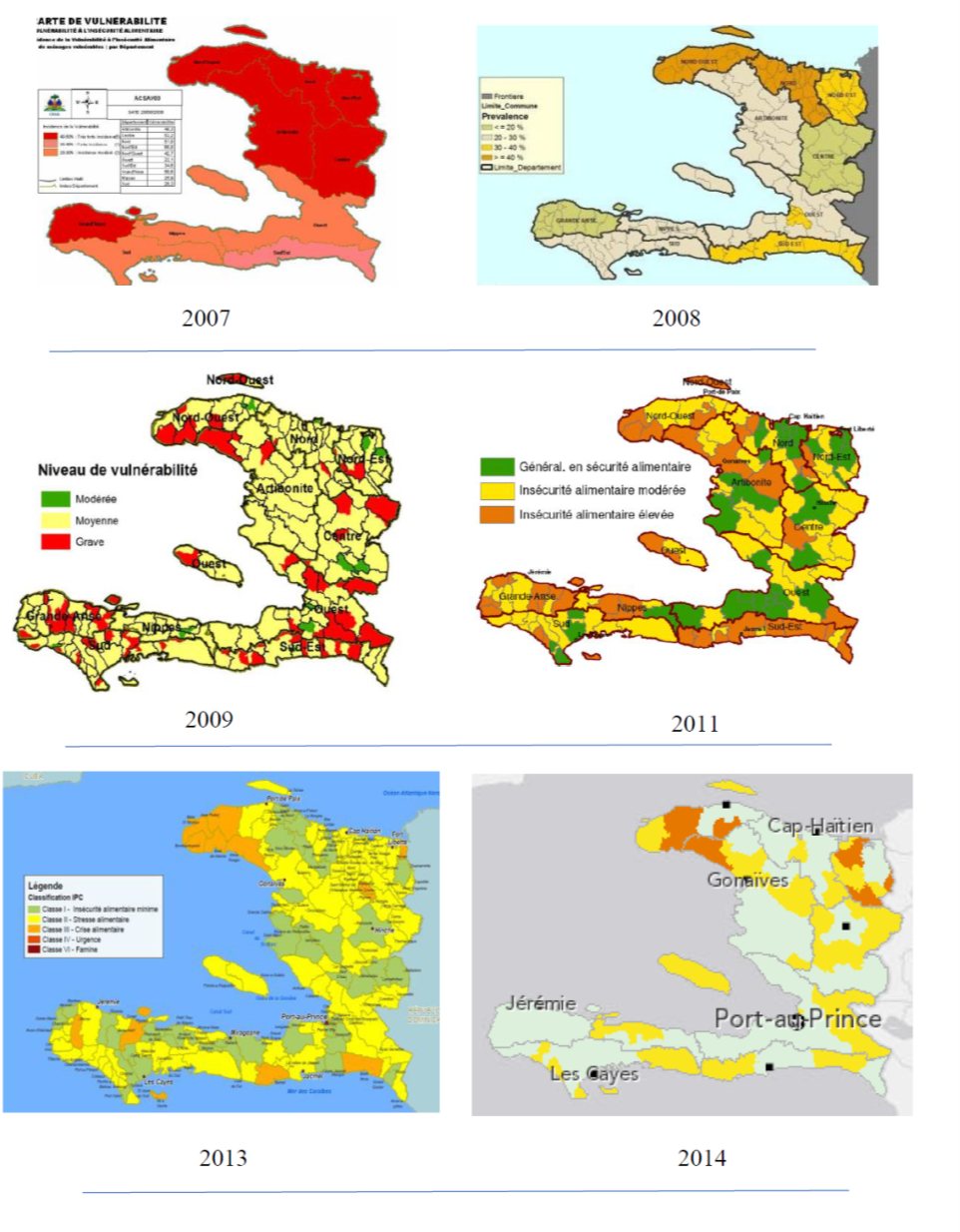It is always very difficult to quantify malnutrition in Haiti. …the data available from actors appears to show that, strictly speaking, there are no pockets of malnutrition. ECHO 2011:24
Although humanitarian aid organizations working in Haiti almost universally target specific departments and communes based on CNSA vulnerability assessments (see CARE 2013a), a longitudinal look at survey data suggests that with the exception of the higher living standards for those in Port-au-Prince metropolitan area and the Department of the West–where Port-au-Prince is located–there is little evidence to justify more than moderate application of geographical criteria in Haiti.
Income
Based on the 2001 HLCS, most departments have essentially equal populations of “extremely poor” people (individuals living on less than US$1 per day), varying between 62 and 72 percent (Figure 1). The only exception by Department were the West and the North East. The West is skewed by metropolitan Port-au-Prince (see Figure 2), by all measures an outlier with respect to the rest of Haiti. The North East with 84 percent of its population extremely poor is arguably not the exception it appears because at the time of data collection 67% of Haiti’s rural population was extremely poor and the North East was, at that time, the least urbanized Department in Haiti. In other words, with the exception of the Department of the West where Port-au-Prince is located, the proportion of the rural and urban population that is extremely poor appears to be essentially the same in all of Haiti’s 10 Departments.
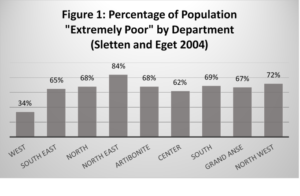

Assets
Based on durable goods (assets), the Genie Coefficient is as an estimation of wealth distribution (a value of 01 indicates egalitarian distribution and 100 total inequality). Once again, with the exception of the Department of the West where Port-au-Prince is located, all the departments rate in the narrow range between 37 to 43 points (see Figure 3; based on the 2012 EMMUS sample of 13,388 households). In other words, the level of equality in distribution of wealth is essentially the same throughout the country’s 10 Departments.[i]
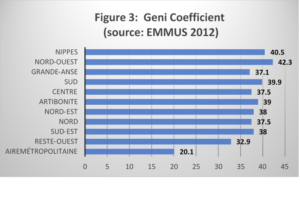
Food Availability and Variation
Variation among Departments regarding months of food scarcity is minimal (Figure 4). Even variation among ecological zones yield small differences (Figure 5). CNSA found that from October 2006 to September 2007 the population of households reporting insufficient alimentation in six ecological-occupational zones fluctuated between highs of 52% and 64% for each zone to lows of 15 to 36 percent; all tended to have the same lean months and the same months of plenty with the one notable exception that agricultural mountain humid, agro-pastoral semi-humid, and agro-pastoral plateau tended to have lower stress during the Autumn months than agro-pastoral dry, mono-cultural plain, and dry agricultural and fishing. Similarly, WFP’s Coping Strategy Index (CSI) (see Figure 5), a 0 to 64-point measure of food deprivation and rationing varies between 20.8 for coastal dry and 24 for Agro-Pastoral Dry, a fluctuation small enough to be attributed to natural sampling error (Figure 6: Wiesmann et al. 2009 for an explanation of CSI).

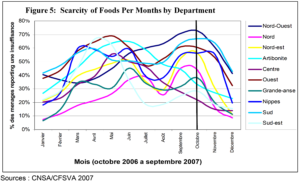
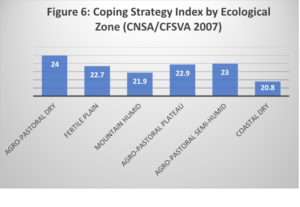
Shocks from Natural Disasters and Internal Household Crisis
The same equality between departments and ecological zones is true for both shocks from natural disasters as well as internal household crisis (Figure 7).
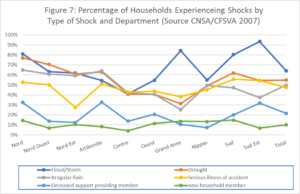
Education
Excepting metropolitan Port-au-Prince, even proportion of adult population that have never been to school is largely equal from one Department to another (Figure 8) as is children in school (Figure 9).
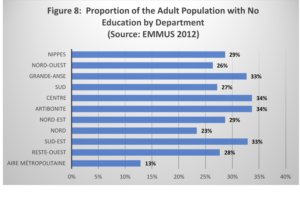
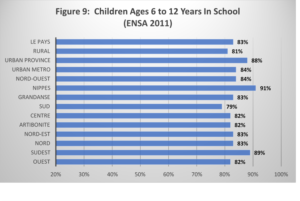
Nutrition
And once again, with the exception of the Port-au-Prince metro area, nutritional status varies little from one Department to another, as can be seen from data on adult nutritional status (Figure 9) as well as child nutritional status (Figure 10).
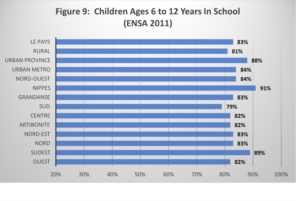
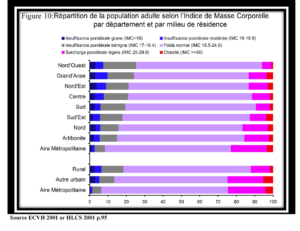
Other Indicators
In the ENSA (2011) and CFSVA (2007) surveys the same general pattern of homogeneity between departments and ecological zones seen above can be found with respect to,
- proportion of income spent on food
- consumption scores
- dependence on markets vs. auto-consumption
- indices of durable goods
- education
- types of livelihood strategies
- remittances from within Haiti
- constraints on livestock rearing
- number of different type of livestock per household
- agriculture
- number of parcels owned
- land tenure
- access to services
- intercropping
- use of fertilizers and
- proportion of population engaged in fishing.
To be sure, there are some differences, for example in regional migration patterns, remittances, and slight differences in dependency on agricultural strategies. CNSA/FEWSNET (2009) documented differences in vulnerability and infrastructure at the sub-department level. But the same figures vary by survey, a probable consequence of sampling error;[ii] and they vary by year, a probable consequence of climate variation and differential temporally idiosyncratic shocks. The variation over time can be seen in nutritional status of children per department (see Figure 10, above); and it can be seen in CNSA/FEWSNET Vulnerability maps (see Figure 12 below). The variation over time, with extremes of vulnerability moving from department or commune to another raise the question: to what degree are differences observed between households a consequence of temporary impacts? Moreover, differences in one variable are offset by others. For example, while in the 2007 CFSVA the department of the Artibonite had the lowest educational level and the highest number of food insecure months, it has the greatest availability of household water sources, irrigated land, and one of the highest rural income levels (at 6.4 in the CNSA/CFVSA p55 and Verner 2008:18). In short, the bulk of the population is uniformly destitute; and advantages in one respect in a particular region are consistently offset by comparatively greater disadvantages in other respects. Even rural urban distinctions can be called into question: the proportion of the population poor in provincial cities and towns vs. those in rural areas are insignificant until one reaches the highest 20% of the population (Figure 3). In summary, if we consider how small the differences in most indicators are between municipal districts and ecological zones, and then we consider change from a longitudinal perspective, the most fantastic thing about geographical profiles in Haiti is the overall homogeneity.
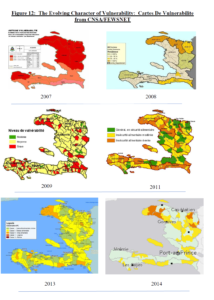
Bibliography
Aba Grangou 2012. WFP/CNSA. Raphy Favre. Unpublished
ALNAP. 2012 Responding To Urban Disasters: Learning From Previous Relief And Recovery Operations November www.alnap.org/resources/lessons.
Bastien, Remy. 1961. Haitian rural family organization. Social and Economic Studies 10(4):478–510.
Berggren, Gretchen, Nirmala Murthy, and Stephen J Williams. 1974. Rural Haitian women: An analysis of fertility rates. Social Biology 21:368–78.
Borgatti, S.P. 1992. ANTHROPAC 4.0 Methods Guide. Columbia: Analytic Technologies.
CARE 2013a The Kore Lavi Program (United States Agency for International Development Bureau for Democracy, Conflict and Humanitarian Assistance Office of Food for Peace
CARE 2013b Gender Survey CARE HAITI HEALTH SECTOR Life Saving Interventions for Women and Girl in Haiti Conducted in Communes of Leogane and Carrefour, Haiti
CFSVA (Comprehensive Food security and Vulnerability Analysis) – 2007/2008. Overseen by WFP (World Food Program) and CNSA (Coordination Nationale de la Sécurité Alimentaire)
CNSA/Few Net 2009 Cartographie de Vulnébilité Multirisque Juillet/Aout 2009
CNSA/Fews Net 2005 Profils des Modes de Vie en Haïti
Concern and Fonkoze 2008 Chemin Levi Miyo – Midterm Evaluation Concern Worldwide, by Karishma Huda, and Anton Simanowitz
DINEPA 2012 Challenges and Progress on Water and Sanitation Issues in Haiti National Water and Sanitation Directorate Direction Nationale de l’ Eau Potable et de l’Assainissement – www.dinepa.gouv.ht
Echevin, Damien 2011 Vulnerability before and after the Earthquake. World Bank Policy Research Working Paper 5850.
http://www.worldbank.org/en/topic/communitydrivendevelopment/brief/cdd-targeting-selection.
ECHO 2011 Real-time evaluation of humanitarian action supported by DG ECHO in Haiti 2009 – 2011 November 2010 -April 2011
EMMUS-I. 1994/1995. Enquete Mortalite, Morbidite et Utilisation des Services (EMMUS-I). eds. Michel Cayemittes, Antonio Rival, Bernard Barrere, Gerald Lerebours, Michaele Amedee Gedeon. Haiti, Institut Haitien de L’Enfance Petionville and Calverton, MD: Macro International.
EMMUS-II. 2000. Enquête Mortalité, Morbidité et Utilisation des Services, Haiti 2000 (EMMUS-II). Cayemittes, Michel, Florence Placide, Bernard Barrère, Soumaila Mariko, Blaise Sévère. Haiti: Institut Haitien de L’Enfance Petionville and Calverton, MD: Macro International.
EMMUS-III. 2005/2006. Enquête mortalité, morbidité et utilisation des services, Haiti 2000 (EMMUS-II). Cayemittes, Michel, Haiti: Institut Haitien de L’Enfance Petionville and Calverton, MD : Macro International.
FAFO 2001 Enquête Sur Les Conditions De Vie En Haïti ECVH – 2001 Volume II
FAFO 2003 Enquête Sur Les Conditions De Vie En Haïti ECVH – 2001 Volume I
GoH 2004 Decree de la Constitution regarding Communal Section LIBERTÉ ÉGALITÉ FRATERNITÉ DE LA RÉPUBLIQUE RÉPUBLIQUE D’HAÏTI DECRET Me BONIFACE ALEXANDRE PRÉSIDENT PROVISOIRE
Government of Haiti 2010 Action Plan for National Recovery and Development of Haiti
Gravlee, C. C., Bernard, H. R., Maxwell, C. R., & Jacobsohn, A. 2013 Mode effects in free-list elicitation: Comparing oral, written, and web-based data collection. Social Science Computer Review 30:119–132.
Gravlee, Lance Dept. of Anthropology, University of Florida The Uses and Limitations of Free Listing in Ethnographic Research
Hashemi, Syed M., and Aude de Montesquiou. 2011. “Reaching the Poorest with Safety Nets, Livelihoods, and Microfinance: Lessons from the Graduation Model.” Focus Note 69. Washington, D.C.: CGAP, March.
Himmelstine, Carmen Leon 2012 Community Based Targeting: A Review of CBT programming and literature
Hoskins, A. 2004. Targeting General Food Distributions: Desk Review of Lessons from Experience. Rome, WFP).
IRIN 2010 Haiti: US Remittances Keep the Homeland Afloat. UN Office for the Coordination of Humanitarian Affairs
http://www.irinnews.org/report/88397/haiti-us-remittances-keep-the-homeland-afloat
Kaufman, Michael. 196. “Community Power, Grasrots Democracy, and the Transformation of Social Life.” In Michael Kaufman and Haroldo Dila Alfonso (eds.), Community Power and Grasrots Democracy: The Transformation of Social Life. London and Otawa: Zed Boks and IDRC.
Kolbe, Athena R., Royce A. Hutson , Harry Shannon , Eileen Trzcinski, Bart Miles, Naomi Levitz d , Marie Puccio , Leah James , Jean Roger Noel and Robert Muggah 2010 Mortality, crime and access to basic needs before and after the Haiti earthquake: a random survey of Port-au-Prince households In Medicine, Conflict and Survival
Krishna, Anirudh 2010 “One Illness Away: Why People Become Poor and How they Escape Poverty” Oxford University Press
Lamaute-Brisson, Nathalie 2009 Pour le ciblage des interventions en matière de sécurité alimentaire. Note d’orientation WFP
Lavallee, Emmanuelle, Anne Olivier, Laure Pasquier-Doumer, and Anne-Sophie Robilliard 2010 Poverty Alleviation Policy Targeting: a review of experiences in developing countries.
Lowenthal, Ira 1984. Labor, sexuality and the conjugal contract. In Haiti: Today and tomorrow, ed. Charles R. Foster and Albert Valman. Lanham, MD: University Press of America.
Lowenthal, Ira. 1987. Marriage is 20, children are 21: The cultural construction of conjugality in rural Haiti. Dissertation, Johns Hopkins University.
Lundahl, Mats. 1983. The Haitian economy: Man, land, and markets. New York: St. Martin’s.
Maguire, Robert E. 1979 Bottom-Up Development in Haiti. Washington, DC: The Inter-American Foundation,
Mansuri, Ghazala and Vijayendra Rao 2013 Localizing Development Does Participation Work? International Bank for Reconstruction and Development / The World Bank
Maxwell, Daniel, Helen Young, Susanne Jaspars, Jacqueline Frize 2009 Targeting in Complex Emergencies Program Guidance Notes. Feinstein International Center, Tufts University
McClure, Marian 1984 Catholic Priests And Peasant Politics In Haiti: The Role Of The Outsider In A Rural Community A paper prepared for presentation at the Caribbean Studies Association meetings St. Kitts May 30 – June 3
Morton, Alice, 1998 The NGO Sector In Haiti: The Challenges of Poverty Reduction, World Bank Volume Il: Technical Papers Report No. 17242-HA
MPCE 2004 Carte de pauvreté d’Haïti, à partir des données de l’ECVH (2001)
Murray, Gerald 1977 The evolution of Haitian peasant land tenure: A case study in agrarian adaptation to population growth. Ph.D. dissertation, Columbia University, Department of Anthropology.
Nicholls, David. 1974. Economic dependence and political autonomy: The Haitian experience. Occasional Paper Series No. 9. Montreal: McGill University, Center for Developing-Area Studies
Pace, Marie with Ketty Luzincourt 2009 Cumulative Case Study: “Haiti’s Fragile Peace”
PAM/CNSA 2007 l’Analyse Compréhensive De La Sécurité Alimentaire Et De La Vulnérabilité
PNUD 2000 Bilan commun de pays du PAM, du FNUAP, de l’UNICEF, de l’OMS/OPS et de la FAO. RPP
Richman, Karen E. 2003. Miami money and the home gal. Anthropology and Humanism 27(2): 119–32.
Romney, A. K., S. C. Weller, and W. H. Batchelder. 1986. Culture as consensus: A theory of culture and informant accuracy. American Anthropologist 88:313–38.
Rotberg, Robert I., and Christopher A. Clague. 1971. Haiti, The politics of squalor. Boston: Houghton Mifflin.
Sali, Jamil 2000 Equity and Quality in Private Education: The Haitian Paradox, Compare, 30(2), 163–178, (p. 165) 3.
Schreiner, Mark 2006 The Progress out of Poverty Index TM: A Simple Poverty Scorecard for Haiti
Schwartz, Timothy. 1998. NHADS survey: Nutritional, health, agricultural, demographic and socio-economic survey: Jean Rabel, Haiti, June 1, 1997–June 11, 1998. Unpublished report, on behalf of PISANO, Agro Action Allemande and Initiative Developpment. Hamburg, Germany.
Schwartz, Timothy. 2000. “Children are the wealth of the poor:” High fertility and the organization of labor in the rural economy of Jean Rabel, Haiti. Dissertation, University of Florida, Gainesville.
Schwartz, Timothy. 2004. “Children are the wealth of the poor”: Pronatalism and the economic utility of children in Jean Rabel, Haiti. Research in Anthropology 22:62–105.
Scott, Lucy and Andrew Shepherd 2013 Microeconomic Indicators of Development Impacts and Available Datasets in Each Potential Case Study Country
Sletten, Pål and Willy Egset. “Poverty in Haiti.” Fafo-paper, 2004.
Smillie, Ian 2001 Patronage or Partnership: Local Capacity Building in Humanitarian Crises Published in the United States of America by Kumarian Press, Inc. 1294 Blue Hills Avenue, Bloomfield, CT 06002 USA.
Smith, Jennie M. 1998. Family planning initiatives and Kalfouno peasants: What’s going wrong? Occasional paper/University of Kansas Institute of Haitian Studies, no. 13. Lawrence: Institute of Haitian Studies, University of Kansas.
Smith, Jennie M., 2001 When The Hands Are Many Ithaca: Cornell University Press.
Smucker, Glenn Richard. 1983. “Peasants And Development Politics: A Study In Haitian Class And Culture”. New School For Social Research. Pages: 511.
Steeve Coupeau 2008: 104 History of Haiti. Greenwood Press: Westport Ct.)
UN 1996 Final report on human rights and extreme poverty, submitted by the Special Rapporteur, Mr. Leandro Despouy’ (28 June 1996) UN Doc E/CN.4/Sub.2/1996/13
UNDP 2011 Cash Programming in Haiti Lessons Learnt in Disbursing Cash Suba Sivakumaran (Subathirai.sivakumaran@undp.org)
USAID (United States Agency for International Development) 1983 Haiti: HACHO Rural Community Development. AID Project Evaluation Report No. 49
USAID 1994 Rapid Assessment Of Food Security And The Impact Of Care Food Programming In Northwest Haiti.
USAID 2013 Performance Indicators Reference Sheets for FFP Indicators
http://www.usaid.gov/sites/default/files/documents/1866/PIRS%20for%20FFP%20Indicators.pdf
Verner, Dorte 2008 Making Poor Haitians Count Poverty in Rural and Urban Haiti
Based on the First Household Survey for Haiti. The World Bank Social Development
Sustainable Development Division World Bank Policy Research Working Paper 4571
WFP (undated_b) Monitoring & Evaluation Guidelines United Nations World Food Programme Office of Evaluation and Monitoring Via Cesare Giulio Viola, 68/70 – 00148 Rome, Italy Web Site: www.wfp.org
WFP 2006a TARGETING IN EMERGENCIES WFP/EB.1/2006/5‐A
WFP 2006b Thematic Review of Targeting in Relief Operations: Summary Report. Ref. OEDE/2006/1
WFP 2009 Targeting in Complex Emergencies, Programme Guidance. Feinstein International Center, Tufts Universtiy
WFP 2013 Basic Guidance Community-Based Targeting
WFP/EB.A/2004/5‐C).
White, T. Anderson And Glenn R. Smucker 1998 Social Capital and Governance in Haiti. In Haiti: The Challenges of Poverty Reduction, World Bank Volume Il: Technical Papers Report No. 17242-HA
WHO 2013. World Health Statistics
http://www.who.int/gho/publications/world_health_statistics/2013/en/
Wiens, Thomas and Carlos Sobrado 1998 Rural Poverty in Haiti In Haiti: The Challenges of Poverty Reduction, World Bank Volume Il: Technical Papers Report No. 17242-HA
Wiesmann, Doris, Lucy Bassett, Todd Benson, and John Hoddinott 2009 Validation of the World Food Programme’s Food Consumption Score and Alternative Indicators of Household Food Security. IFPRI Discussion Paper 00870
World Bank 1998 Haiti: The Challenges of Poverty Reduction (In Two Volum-les) Volume Il: Technical Papers Report No. 17242-HA
World Bank 2011 Working Research Paper Echevin2011 Vulnerability before and after the Earthquake. by Damien Echevin World Bank Policy Research Working Paper 5850. http://www.worldbank.org/en/topic/communitydrivendevelopment/brief/cdd-targeting-selection.
World Bank 2013 Design & Implementation: Targeting and Selection. http://www.worldbank.org/en/topic/communitydrivendevelopment/brief/cdd-targeting-selection
Zaag, Raymond Vander, 1999 Encounters Of Development Knowledges, Identities And Practices In A Ngo Program In Rural Haiti Doctoral Dissertation, Department of Geography and Environment Studies Carleton University Ottawa, Ontario, Canada
Zak, Marilyn and Glen Smucker HAITI DEMOCRATIC NEEDS ASSESSMENT May 1989 USAID (United States Agency for International Development) Office of Caribbean Affairs Bureau for Latin America and the Caribbean
NOTES
[i] In effect, allotting for sampling error, distribution of wealth within Haiti’s 10 Departments is essentially equal for all except the West, where the metropolitan area of Port-au-Prince is located (and is substantially lower at 20.1).
[ii] This situation only slightly improved in 1999, as 48.0% were then categorized as poor. In 2001, the HLCS stated that 55.6% of households lived with less than US$1 per day (Echevin 2011: 2)


